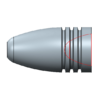I know. But how do you or I make use of that information? The same load tested both ways will give different numbers. It seems that most of the stuff retested by piezoelectric transducer leads to a lower published maximum powder charge. Because the electronics pick up a short sharp peak that the crusher cannot physically respond to. But that old CUP load served for decades. Was it really deep into the safety margin of the gun as proof tested... based on CUP readings?
Without pressure gauges, and reliable design information for the fatigue lifetime information on firearms, we reloaders are back in the days of spirits, demons, and devils. We really don't know what is going on inside that chamber.
So, what do you do? I for one don't push it. I believe, without data to back this belief, that if my loads are going faster than pressure tested, then the pressures are higher. If I have pierced primers, blown primers, I consider that proof positive of over pressure loads. I am of the opinion, when I have sticking cases, I am way over pressure. I have shot enough hot reloads, without sticking extraction, that the lack of friction does not prove much of anything.
This youtuber is testing old Turkish 8mm ammunition and claiming it is safe.
Shooter claims Turkish S ball ammunition, 154 gr bullet, claims 2980 fps factory. In his 29 inch M98 Mauser, the only velocity measurement was 3200 fps and the one round fired had a split case neck.
As a reference, from
Mauser Bolt Rifles by Ludwig Olson, 3rd edition
German 7.9 mm Model S cartridge
Bullet diameter: 0.323”
Bullet weight: 154 fps
Muzzle velocity 2936 fps (29.13” barrel)
Max pressure: 44,082 psi
German 7.9 mm Model sS cartridge
Bullet diameter: 0.323”
Bullet weight: 198 fps
Muzzle velocity 2575 fps (29.13” barrel)
Max pressure: 46,926 psi
Remarks: muzzle velocigty with 23.62” barrel is 2476 fvps

He then shifts to a Gewher G43 rifle that has a 21.5 inch barrel. Shooter starts off with “fresh” Yugo ammunition.Ends up with Turkish.
2505 fps Yugo
2515 fps Yugo
3080 fps Turk
3010 fps Turk
The shooter may not be having sticky extraction, but he is not beating the bolt open. But his velocities are high. Does anyone think 3010 fps out of a 21.5 inch barrel is reasonable based on known issue pressures and velocities?
I am sure a good quality, new firearm will take over pressures for a while. But something that has already gone through a lot of shots, I would not push it. Metal fatigue is real. Happens all the time. On all sorts of things.









